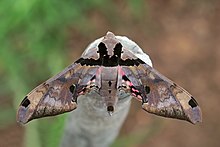| Lepidoptera Temporal range: Early Jurassic–Present,
| |
|---|---|

| |
| Peacock butterfly (Aglais io) | |

| |
| Adhemarius gannascus, a species of sphinx moth | |
| Scientific classification | |
| Domain: | Eukaryota |
| Kingdom: | Animalia |
| Phylum: | Arthropoda |
| Class: | Insecta |
| (unranked): | Amphiesmenoptera |
| Order: | Lepidoptera Linnaeus, 1758 |
| Subdivisions | |
Lepidoptera (/ˌlɛpɪˈdɒptərə/ LEP-ih-DOP-tər-ə) or lepidopterans is an order of winged insects which includes butterflies and moths. About 180,000 species of the Lepidoptera have been described, representing 10% of the total described species of living organisms,[1][2] making it the second largest insect order (behind Coleoptera) with 126 families[3] and 46 superfamilies,[1] and one of the most widespread and widely recognizable insect orders in the world.[4]
Lepidopteran species are characterized by more than three derived features. The most apparent is the presence of scales that cover the bodies, large triangular wings, and a proboscis for siphoning nectars. The scales are modified, flattened "hairs", and give butterflies and moths their wide variety of colors and patterns. Almost all species have some form of membranous wings, except for a few that have reduced wings or are wingless. Mating and the laying of eggs is normally performed near or on host plants for the larvae. Like most other insects, butterflies and moths are holometabolous, meaning they undergo complete metamorphosis. The larvae are commonly called caterpillars, and are completely different from their adult moth or butterfly forms, having a cylindrical body with a well-developed head, mandible mouth parts, three pairs of thoracic legs and from none up to five pairs of prolegs. As they grow, these larvae change in appearance, going through a series of stages called instars. Once fully matured, the larva develops into a pupa. A few butterflies and many moth species spin a silk casing or cocoon for protection prior to pupating, while others do not, instead going underground.[4] A butterfly pupa, called a chrysalis, has a hard skin, usually with no cocoon. Once the pupa has completed its metamorphosis, a sexually mature adult emerges.
Lepidopterans first appeared in fossil record in the Triassic-Jurassic boundary and have coevolved with flowering plants since the angiosperm boom in the Middle/Late Cretaceous. They show many variations of the basic body structure that have evolved to gain advantages in lifestyle and distribution. Recent estimates suggest the order may have more species than earlier thought,[5] and is among the five most species-rich orders (each with over 100,000 species) along with Coleoptera (beetles), Diptera (flies), Hymenoptera (ants, bees, wasps and sawflies) and Hemiptera (cicadas, aphids and other true bugs).[4] They have, over millions of years, evolved a wide range of wing patterns and coloration ranging from drab moths akin to the related order Trichoptera, to the brightly colored and complex-patterned butterflies.[3] Accordingly, this is the most recognized and popular of insect orders with many people involved in the observation, study, collection, rearing of, and commerce in these insects. A person who collects or studies this order is referred to as a lepidopterist.
Butterflies and moths are mostly herbivorous (folivorous) as caterpillars and nectarivorous as adults. They play an important role in the natural ecosystem as pollinators and serve as primary consumers in the food chain; conversely, their larvae (caterpillars) are considered very problematic to vegetation in agriculture, as they consume large quantity of plant matter (mostly foliage) to sustain growth. In many species, the female may produce from 200 to 600 eggs, while in others, the number may approach 30,000 eggs in one day. The caterpillars hatching from these eggs can cause significant damage to crops within a very short period of time. Many moth and butterfly species are of economic interest by virtue of their role as pollinators, the silk in their cocoon, or for extermination as pest species.
- ^ a b Mallet, Jim (12 June 2007). "Taxonomy of Lepidoptera: the scale of the problem". The Lepidoptera Taxome Project. University College, London. Archived from the original on 5 June 2011. Retrieved 8 February 2011.
- ^ "Lepidoptera Taxome Project". Lepidoptera Taxome Project. Archived from the original on 5 August 2011. Retrieved 25 February 2015.
- ^ a b Capinera, John L. (2008). "Butterflies and moths". Encyclopedia of Entomology. Vol. 4 (2nd ed.). Springer. pp. 626–672. ISBN 9781402062421. Archived from the original on 24 June 2016. Retrieved 22 September 2016.
- ^ a b c Powell, Jerry A. (2009). "Lepidoptera". In Resh, Vincent H.; Cardé, Ring T. (eds.). Encyclopedia of Insects (2 (illustrated) ed.). Academic Press. pp. 557–587. ISBN 978-0-12-374144-8.
- ^ Kristensen, Niels P.; Scoble, M. J.; Karsholt, Ole (2007). "Lepidoptera phylogeny and systematics: the state of inventorying moth and butterfly diversity" (PDF). In Z.-Q. Zhang; W. A. Shear (eds.). Linnaeus Tercentenary: Progress in Invertebrate Taxonomy (Zootaxa:1668). Magnolia Press. pp. 699–747. ISBN 978-0-12-690647-9. Archived from the original (PDF) on 15 May 2013. Retrieved 2 March 2010.